The Loire Valley Gastronomy
I am a wine and food enthusiast and I want the wine tastings I organise to be super savory and tasty. That's why they always associate wine and food, mostly made from local products. Because I think that a good bottle of wine is always better enjoyed when tasted with quality food. And because I am eager to have visitors discover the great diversity of local delicacies produced in the Touraine region and in the Loire Valley.
During your stay in this region, you will inevitably be able to taste and enjoy the delicious gourmet treats produced in the area. Here are a few local specialties you will be able to try while taking part in one of the wine tours and/or wine tastings I organise.
"Charcuterie"
Rillons de Touraine
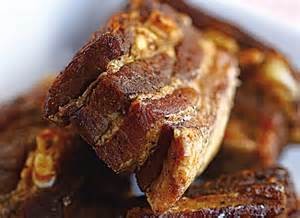
Rillons are one of the most famous specialties in Tours and in the Touraine region. They consist in pieces of pork belly that are seasoned and cooked before they are stewed in pork fat for about two hours. Not very healthy, some will say! But rillons are so good when the tender pork meat melts in your mouth, leaving a smoky aftertaste once they have been swallowed. Note that rillons is always used in the plural, even though you may eat only one piece of meat!
They can be sliced and fried for just a minute in a pan, then served on lettuce with toast and goat cheese melted in the oven - the best option being the local goat cheese called Sainte-Maure-de-Touraine.
You'll find them in any good local charcuterie shop, in regular or small size, in which case they are called rillons cocktail and can be served warm or cold, at aperitif time. To try with a sparkling or dry Vouvray or Montlouis-sur-Loire or a light Loire red wine.
Rillettes de Tours

A famous recipe since the 15th century, the rillettes de Tours have been classified as IGP (Geographically Protected Indication) since 2013 - which is not the case of their neighbours, the rillettes made in Le Mans, yet generally better-known by the consumers as they can be found in any French supermarket.
Rillettes are made with pork meat cooked in a cauldron, in pork fat, between 6 and 12 hours. The meat can be flavoured with wine or wine spirit.
The rillettes de Tours (a name always used in the plural, like the other famous local specialty, rillons - see description above) are a pork spread characterised by clearly visible pork meat fibers as well as by pieces of pork meat. They are not as fat as the rillettes produced in Le Mans.
Rillettes are eaten on a slice of bread (or can be used to prepare a sandwich) and served with a Loire Valley dry or semi-dry white wine made with Chenin Blanc (Vouvray, Montlouis-sur-Loire...) or a light Loire red wine such as Saint-Nicolas-de-Bourgueil, Bourgueil, Chinon, Anjou rouge, Touraine...
The 'quiche tourangelle' (Touraine's quiche)

Take some rillettes de Tours, spread them on a pie shell (short pastry), put on top some thin slices or dices of rillons de Touraine then a mix of beaten eggs, cream or milk, parsley, salt and pepper. Bake in the oven until the top is golden.
It's rich, but how delicious! To be eaten cold in summer for a picnic in the vineyard, or warm in winter and to enhance the creaminess in your mouth.
Here is a local address to try it: Charcuterie Jean-Jacques Bergère in Vernou-sur-Brenne (37), near Vouvray.
Andouillette
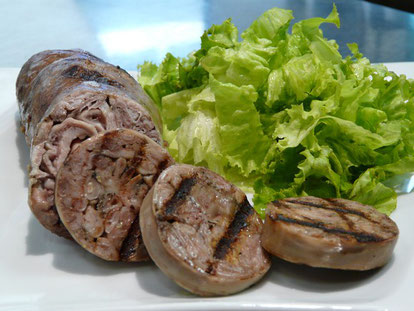
Andouillette is one of the specialties of Tours. It is a sausage prepared with pork meat - and in particular with pork offal - that is cut into long stripes and seasoned with salt, pepper and spices. The meat is cooked for at least 3 hours in a 'court bouillon' (no translation in English for this technical word referring to a mixture of water, salt, pepper, white wine - in that case Vouvray wine, vinegar, carrots, onions and herbs) - a long and slow cooking that allows the meat to soak up the aromas of the white wine.
During the wine tastings, it is difficult for Myriam to serve andouillette, as the sausages have to be grilled, either on a barbecue, in a frying pan or in the fireplace, before they are eaten warm. They are very often available in the local restaurants, where they are served with chips, mashed or fried potatoes...
However we have managed to find a terrine made with andouillette at a local 'charcuterie'. It is generally very much appreciated by our visitors. Even the people who are not so fond of andouillette because they find it too strong agree that the terrine is delicious.
Andouillettes should be tasted with a light Loire Valley wine such as Saint Nicolas de Bourgueil, Chinon, or Coteaux du Loir... or with a dry Vouvray white wine - a perfect match as it is the wine that is used to cook the meat!
Beuchelle 'à la tourangelle'

The beuchelle 'à la tourangelle' is an old recipe that may not be to everyone's taste as some of its main ingredients include calf sweetbread and kidneys. They are served with mushrooms in a creamy sauce.
I've only had the opportunity to try this dish once, since not that many restaurants serve it in the Loire Valley. If you come to Tours, you can try it at a restaurant called 'La Ruche', located in the rue Colbert. Their beuchelle is light and well-seasoned, and the meat is perfectly cooked... delicious!
Another address whose specialty is the beuchelle is the restaurant 'Le Barju' in the old neighbourhood of Tours, near the Place Plumereau.
What Loire Valley wine should you try with this local dish? A dry Vouvray or Montlouis-sur-Loire, a white Chinon, a Savennières. All these wines are made with Chenin Blanc, a grape variety that offers high acidity that should contrast with the cream in the sauce. A perfect match!
Loire fish
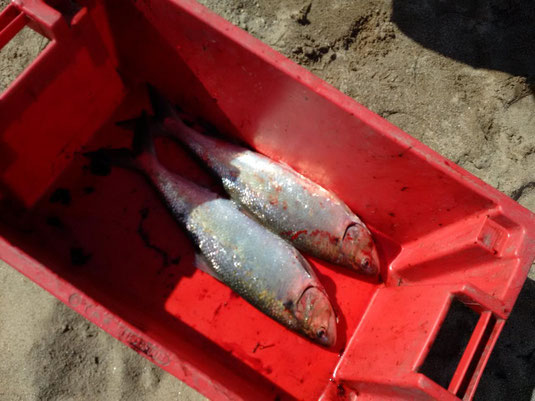
Nowadays there are about 10 professional fishermen working on the Loire river, and a few of them fish in the Touraine region, between Amboise and Chinon. This old job is becoming fashionable again!
Mulets, blueback herrings, pikes, barbels, pike perches, salmon, lampreys, giant catfish... are some of the species found in River Loire.
The Loire fish rillettes served during the wine tastings organised by Myriam of Loire Wine Tours are made by Nicolas Hérault, a professional fisherman living and fishing near Chinon. You will be able to buy his products directly after the wine tours run by Myriam at Vignoble Alain Robert, or at the following grocery stores: La Balade Gourmande in Tours and Galland Terroirs in Amboise.
The smoked giant catfish sometimes served during the wine tastings is produced by another fisherman called Thierry Bouvet.
Here are a few addresses where you can eat Loire fish, if you feel like trying them:
- La Cabane à Matelot, a restaurant owned by Romain Gadais, a professional fisherman, in Bréhémont, near Langeais
- Restaurant Au Martin Bleu in Tours
- Restaurant Au Chapeau Rouge in Chinon
Goat cheeses
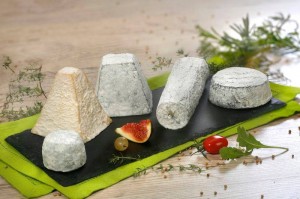
Here they are, the stars of the Loire Valley! Indeed, we should talk about goat cheeses, in the plural. There are so many of them! Will you be able to recognise them?
From left to right: crottin de Chavignolles (produced in the Sancerre region), Pouligny Saint Pierre, Valençay, Sainte-Maure-de-Touraine, Selles-sur-Cher. All AOC cheeses! In case you don't know what AOC means, book a wine tour with Myriam, she'll give you loads of explanations about French AOCs.
These cheeses are the most famous ones but the Loire Valley teems with farm cheeses, that are unique because made by small local producers. You will be able to buy them on local markets or by visiting directly the goat farms.
Which Loire Valley wines should you taste with the goat cheeses produced in the area? A white wine made with Sauvignon Blanc (Touraine-Chenonceaux, Touraine-Oisly, Sancerre, Pouilly-Fumé, Menetou-Salon, Quincy...) or Chenin blanc (Vouvray, Montlouis-sur-Loire, Anjou blanc, Saumur blanc).
Here are a couple of addresses to see the making of goat cheese, to try it and to buy some:
- a farm called La Ferme du Cabri au Lait, located in Sepmes (south of Tours), where Claire Proust and Sébastien Beaury will have you meet their goats and experience their production thanks to visits and workshops scheduled at different times of the year.
- the cheese shop fromagerie Moreau (in Pontlevoy, south-west of Blois) where Jean-Luc Billien, a passionate of cheese in general and of goat cheese in particular, will tell you everything about the making and ageing of cheese. During the week, go there in the morning to see how the goat cheeses are made.
Fouées
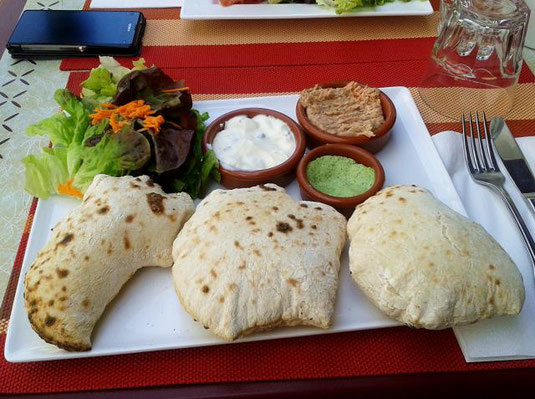
These little warm breads are made with bread dough leftovers. The dough is flattened, then baked for a few minutes in a traditional fire bread oven - time for the dough to rise. Fouées are served warm, people to slice them and stuff them with rillettes, goat cheese, garlic butter...
Many troglodyte restaurants near Amboise, Tours, Saumur and Angers offer full meals based on fouées and a variety of stuffings.
I love them! The problem is that you can generally eat as many as you want in the restaurants mentioned above, and they are extremely addictive: when you start eating one, you want to try all the stuffings... !
To eat with a dry or off-dry white wine or a light red wine from the Loire Valley, depending on the stuffings you will choose.
Rabelais's fouace

This delicious brioche includes some walnuts, honey and spices in its recipe. It can be tasted by itself but for a perfect match, it is best eaten with other Loire Valley specialties, such as some Sainte Maure de Touraine goat cheese, some rillettes de Tours, or other food products like foie gras or marmalade...
The recipe is given by Rabelais, a French 16th-century author native of the Loire Valley, in his famous novel Gargantua. Fouaces are considered as 'viande céleste' - heavenly meat - by Rabelais. The plot takes place near Chinon, in the small village of Seuilly, where Rabelais was born, in a house called la Devinière, that you can still visit today. In the novel, fouaces are at the origin of a war between peasants of neighbouring villages, after the bakers of Lerné refuse to sell the fouaces they have made to the shepherds of the next village…Hopefully these little brioches trigger no more conflict nowadays, as everybody agrees they are absolutely delicious.
Saffron

Did you know that some saffron is produced in the Loire Valley, and more precisely in the Touraine region?
Many visitors find out about this production when they come and take part in a wine tour and wine tasting with Myriam. One of the Loire fish rillettes served with the sparkling wines produced at the family winery is actually made with smoked mulet from the Loire river and locally-produced saffron.
Saffron is now grown by about 30 producers in the area. It has been grown in the Loire Valley for a long time, but this production had completely disappeared between the 1940s and the 1990s. It is the pistils that are harvested in the autumn, then dried for preservation and consumption. Saffron flowers come from a beautiful variety of purple crocus called 'crocus sativus', that likes growing in clay and limestone soils - a type of soil found in the Loire Valley and also particularly adapted to vineyards! One needs to pick 150 flowers to get 1 gramme of saffron, which explains the very high price of the final product!
If you want to discover how saffron is grown and buy some, you can visit Véronique's farm in Saint Epain (south of Tours): www.chantdeble.fr
Truffles

Another noble product found in the Loire Valley. Truffle-growing is said to have started at the end of the 18th century, in the region of Loudun, south of Chinon. Nowadays, 700 hectares are planted with truffle-trees and dedicated to growing truffles in the region. Most of the production comes from the region of Chinon, south-west of Tours.
The most popular variety is the black truffle - tuber melanosporum, which is harvested from December to February. If you come and visit the Loire Valley in winter, you may have the opportunity to attend one of the markets dedicated to selling truffles in Marigny-Marmande (5 dates from December to February, near the beautiful town of Richelieu) or to the festival organised every year in Chinon.
This article is for me the opportunity to give you a recipe: black truffle butter. Grate 25g of fresh black truffle and rub it with 250g of good quality butter. Add some salt, to your taste. Make a roll and put it into cling film. Leave for 48 hours in the fridge, to let the butter soak up the aromas of the truffle. You can deep-freeze the butter to consume it when needed.
Walnut oil

Walnut oil had become unpopular for some time, because it was considered as too strong by some consumers. However until the 20th century, it was the most popular and most consumed oil in the Touraine region. If you take part in one of Myriam's wine tours in the Vouvray vineyard, you will get to see quite a few walnut trees. In the past they were very often planted in the local countryside, in particular in the places where the sub-soil is made of limestone, which is a type of rock really favorable to the growth of this variety.
In the past people harvested the walnuts in the autumn and in winter they would spend the evenings all together in front of the fireplace to crack the nuts and press them to make their own oil. The walnut oil produced in the Touraine region was well-known in the 18th century. Production decreased during the 20th century beacuse of land consolidation.
Orléans vinegar

This specialty has an interesting history linked to wine production. The Loire Valley wines leaving the region were shipped by boat on the river. Some went down the Loire to Nantes, from where they were then exported to Northern Europe. Others travelled up the river towards Paris. This was a slightly more perilous itinerary because the sailors were dependent on the westerly winds, which allowed them to sail up the river. These winds are said to blow about 1/3 of the year. The boats were therefore sometimes blocked, which did not help the conservation of the wines - they were transported in barrels at the time and were subject to weather changes.
The spoilt wines which reached in Orléans were used to make vinegar, thus making this product the specialty of the city. While there were between 200 and 300 vinegar makers in Orléans at the end of the 18th century, there is only one left today: the Pouret house.
Desserts and confectioneries
Nougat de Tours
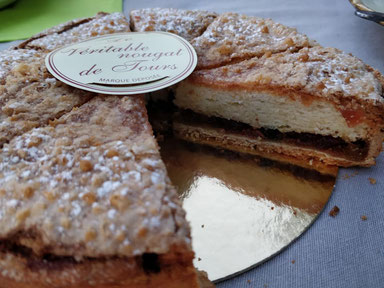
When you tell French people about nougat, they immediatly think about a hard or chewy candy made with dried almonds in the south-east of France. But in Tours, nougat is not a sweet, it is... a cake! Light shortbread on which apricot jam and candied fruit are spread before they are covered with 'macaronade' - a mix of beaten egg white, powdered almond and sugar. After it has baked in the oven and cooled down, the cake is sprayed with icing sugar. The name 'nougat' comes from the fact that the cake includes ingredients similar to those found in the sweet: almonds, egg white and icing sugar.
Good news for the gourmets! Nougat de Tours is a cake that travels well: you don't need to put it in the fridge and it will keep for about 10 days. A good opportunity to visit a baker's to buy some and to put it in your suitcase for when you leave the Loire Valley! Serve it with a semi-dry sparkling rosé wine or a semi-dry sparkling Vouvray - these are wines you may get to try during your wine tasting with Myriam and that you will be able to buy at cellar-door prices at the end of your wine tour directly from Myriam's husband's winery.
Macarons of Cormery
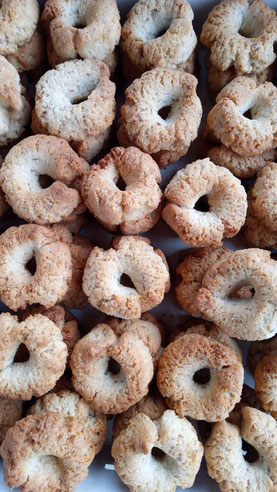
Egg white, sugar and powdered almonds... these are the only ingredients you need to bake these lovely cakes that are unique in France, since they are only made in one village in the country!
These macaroons come from Cormery, a village located in the south-east of Tours. A beautiful place along River Indre - a tributary of the Loire river - where you can still find the ruins of a former abbey. Actually the recipe is said to have invented by one of the monks in charge of cooking there. The story says that a young man whose fiancée had died decided to become a monk in Cormery. He kept the engagement ring as a souvenir. Over the years he became a greedy and old monk, and one day, when going through the kitchen, he dipped his finger into a bowl to try what the chef was preparing. The ring fell in the dough... which inspired the chef and gave him the idea of creating little cakes with a round shape.
Nowadays, two bakers bake and sell macaroons in Cormery. Each of them has its own recipe considers he owns the original one! 'Aux vrais macarons de Cormery' vs 'Aux véritables macarons de l'abbaye de Cormery'. Which ones ar the best? We can't answer for you! Go and spend some time in this lovely village to try the two recipes, maybe you'll have a favourite?
To taste with a sweet or super sweet Vouvray or Montlouis-sur-Loire or a sweet wine from Anjou (Coteaux du Layon, Coteaux de l'Aubance, Bonnezeaux...)
The winemaker's tart ('la tarte vigneronne')

A few very simple ingredients make this light and delicious local dessert: a thin layer of caramelized puff pastry, some apple slices and on top of that, a spoonful of local red wine jelly (in general Chinon or Bourgueil wine, as the original recipe comes from that area).
To be paired with a semi-dry sparkling rosé, a semi-dry still rosé such as Cabernet d'Anjou or Rosé d'Anjou, and why not try a light red wine with it!
Two bakeries where you can buy this 'tarte du vigneron' : boulangerie Riveiro in Vouvray et boulangerie Guérin in Nazelles-Négron (near Amboise). Once you'll have tried it, you'll want more, for sure! And if you want to make it yourself, you will find the recipe on our blog (link below).
Poires tapées from Rivarennes

How could we translate the name of this unique recipe originating from the village of Rivarennes, west of Tours? 'Beaten pears' seems to be the appropriate expression...! In fact,pPears are peeled, then slowly dried out in a traditional bread oven before they are flattened thanks to a wooden tool called 'platissoir' (see in the picture) to get rid of all the air and the water that might be left in the fruit. This technique allows the pears to be kept for years. They have to be rehydrated into wine or sugared water before they can be used for cooking or baking.
This method was born thanks to the phylloxera crisis - in case you don't know what the phylloxera crisis is, come and join one of Myriam's wine tours, this is something she explains during the guided walks she gives in the vineyard. In the late 19th century, the local winemakers had to dig out their dying vines and started planting fruit trees such as apple and pear trees as a substitute. The villagers of Rivarennes developed another production and the technique of beating the fruit to make a living... until the 1930s when people started using refrigerators! The production of beaten pears was forsaken until it was revived at the end of the 1980s.
'Le Balzac'

If you like France or have studied French, you probably have heard of the famous writer Honoré de Balzac. He was born in Tours in 1799, in a house located in the main street of the city, now called 'rue Nationale'. He loved the Loire Valley and regularly came and spent time in the area, especially in a manor house located in the village of Saché that was owned by his mistress, Madame Hanska, and that is now open to visitors.
In 2019, to celebrate the 220th anniversary of Balzac's birth, the local bakers worked together to create a cake bearing his name. 'Le Balzac' is inspired by another French cake called 'Saint Honoré' - a reference to Balzac's first name - and includes coffee as one of its ingredients, a drink that the French writer loved particularly, more than wine - he is said to have consumed up to 50 cups of coffee a day! He considered this drink as necessary for his inspiration.
But let's come back to our cake! The bottom is made of a crunchy biscuit, covered with a light mousse and a series of cream puffs and whipped cream ('chantilly' in French). The cake combines chocolate, vanilla, caramel and coffee flavours, for a delicious result! 16 local shops in the Touraine region bake and sell this cake, and in particular Mr and Mrs Huvet, whose 'boulangerie-pâtisserie' is located in Vernou-sur-Brenne, just a few minutes's drive from our vineyard and family winery.
What should you drink with this dessert? A sparkling wine from the Loire Valley... or a nice cup of coffee to match with one of the ingredients of the cake!
Cotignac d'Orléans
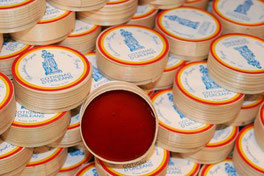
Cotignac d'Orléans is a soft and melting quince paste sold in a small spruce box showing Joan of Arc's portrait - she is the heroin of the city as she freed Orleans from the English in 1429. This confectionery was once sold by apothecaries for its anti-diarrheal properties and to regulate digestive problems. Today there is only one manufacturer, who produces around 25,000 boxes of 22 grammes each, every year.